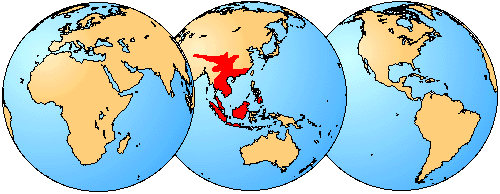Megophryidae
David Cannatella- Atympanophrys
- Brachytarsophrys
- Leptobrachella
- Leptobrachium
- Leptobrachium
- Leptolalax
- Megophrys
- Ophryophryne
- Oreolalax
- Scutiger
- Vibrissaphora
Introduction
Megophryids are the largest and most diverse family-level group of non-neobatrachian frogs. They are found in India, Pakistan, and eastward into southeast Asia, Borneo and the Philippines to the Sunda Islands. They range in size from about 20 to 125 mm.
Some are large, cryptic, forest-floor dwellers with adaptations for large prey. Their skin is modified so that they resemble dead leaves on the forest floor. Some species have points of skin on the eyelids, which further enhances the illusion (Megophrys montana). Others, such as Leptobrachella mjobergi, are small, with digital discs and are found on rocks along streams.
Some megophryids have pond-type tadpoles; others have stream-dwelling tadpoles, some with surface-feeding mouths and some with large buccal areas for clinging to rocks.
All megophryids for which data are available have unusually ossified intervertebral disks, and hyoid plates that lack most of the ceratohyals. There are no known fossils.
Discussion of Phylogenetic Relationships
Ford and Cannatella (1993) defined the node-based name Megophryidae to be the common ancestor of living megophryines (Atympanophrys, Brachytarsophrys, Leptobrachella, Leptobrachium, Leptolalax, Megophrys, and Scutiger), and all its descendants. Putative synapomorphies include the complete or almost complete absence of ceratohyals in adults, intervertebral cartilages with an ossified center, and paddle-shaped tongue (Regal and Gans, 1976). Only two of the seven genera were analyzed by Cannatella (1985), but ongoing studies of other taxa by Cannatella corroborate these synapomorphies. The monophyly of megophryids has not been questioned.
References
Cannatella, D. C. 1985. A phylogeny of primitive frogs (archaeobatrachians). Ph.D. Dissertation, The University of Kansas, Lawrence.
Ford, L. S., and D. C. Cannatella. 1993. The major clades of frogs. Herp. Monogr. 7:94-117.
Regal, P. J., and C. Gans. 1976. Functional aspects of the evolution of frog tongues. Evolution 30:718-734.
Title Illustrations

| Image Use |
 This media file is licensed under the Creative Commons Attribution-ShareAlike License - Version 3.0. This media file is licensed under the Creative Commons Attribution-ShareAlike License - Version 3.0.
|
|---|---|
| Copyright |
© 1995 David Cannatella

|
About This Page
If you are interested in authoring or co-authoring the page for this taxon, or some part of it (even a species), contact David Cannatella.
David Cannatella

University of Texas, Austin, Texas, USA
Correspondence regarding this page should be directed to David Cannatella at
Page copyright © 1995 David Cannatella
 Page: Tree of Life
Megophryidae.
Authored by
David Cannatella.
The TEXT of this page is licensed under the
Creative Commons Attribution License - Version 3.0. Note that images and other media
featured on this page are each governed by their own license, and they may or may not be available
for reuse. Click on an image or a media link to access the media data window, which provides the
relevant licensing information. For the general terms and conditions of ToL material reuse and
redistribution, please see the Tree of Life Copyright
Policies.
Page: Tree of Life
Megophryidae.
Authored by
David Cannatella.
The TEXT of this page is licensed under the
Creative Commons Attribution License - Version 3.0. Note that images and other media
featured on this page are each governed by their own license, and they may or may not be available
for reuse. Click on an image or a media link to access the media data window, which provides the
relevant licensing information. For the general terms and conditions of ToL material reuse and
redistribution, please see the Tree of Life Copyright
Policies.
- Content changed 28 November 2008
Citing this page:
Cannatella, David. 2008. Megophryidae. Version 28 November 2008 (under construction). http://tolweb.org/Megophryidae/16978/2008.11.28 in The Tree of Life Web Project, http://tolweb.org/









 Go to quick links
Go to quick search
Go to navigation for this section of the ToL site
Go to detailed links for the ToL site
Go to quick links
Go to quick search
Go to navigation for this section of the ToL site
Go to detailed links for the ToL site